

Sunday 1st November 1998 was an memorable day for me. It was the day I received an e-mail from Chris Bennett. He'd found three Lucas GTS/APUs (Gas Turbine Starter/Auxiliary Power Unit) at an aircraft dealer's yard, and did I want in ?
For this selfless act of mateship Chris has earned my eternal gratitude. (Well, a free breakfast, at least.)
We were introduced to this particular small gas turbine unit by Ian Bennett, who has made it his life's work to acquire more gas turbines than the Smithsonian Institute (except that his machines are RUN regularly !)
The APU is attached piggy-back to the Pegasus main engine in a Harrier aircraft. It is used to provide electrical services to the aircraft when the main engine is not in use, and also to start the main engine.
Here are left and right views of the unit 'as collected'. (Left click on the images to view larger versions ~80k)
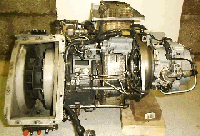
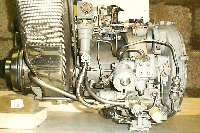
The core 'gas generator' of the unit is a compressor/turbine arrangement similar to an auto turbocharger. This is integrated with an annular reverse flow combustor and a gearbox to provide drive for fuel and oil pumps.
Click here to download (200k) a detailed cutaway view of the gas generator part of the unit.
The gas generator rotor is assisted to self-sustain speed by a small 24V electric motor. The exhaust gases from the gas generator assembly are expanded through an axial power turbine (see background) to drive the output shaft via a reduction gearbox and solenoid activated dog clutch assembly.
Chris Bennett and I have worked together to return these units to running condition.
The electrical equipment (alternator, starter motor and ignition unit) had been removed from these units when they were taken out of service by the RAF.
The first job then was to find an alternative starter motor, for which we chose a readily available motorcycle unit. Since this would have to run at high speed, we modified it to take ball races, reinforced the windings with Kevlar, balanced the rotor and had made a suitable splined adaptor to mate with the existing starter drive socket.
Chris Bennett welded up a nice box frame to mount the units (Great job Chris !), see the images of the completed unit below.
Fuel and oil tanks were added, to fit in the frame, and the associated piping fitted.
Instrumentation includes a tacho, EGT display and various indicators. I also decided that I would design a simple circuit to provide a 'press-to-start' function. This is entirely based on relays, and although lacking in microcontrollers has proved to work reliably !
As well as press-to-start, the control circuit allows the APU to be powered down to 'Idle' mode, so that the power turbine brake can be applied, and the power take-off dog clutch solenoids can be energised. Interlocks are provided so that the brake and dog clutch can only be selected in 'Idle' mode.
The images below show the completed APU installation.
(Click to view a more detailed image ~100kB)
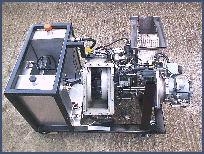
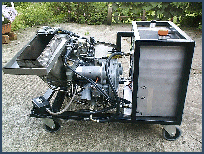
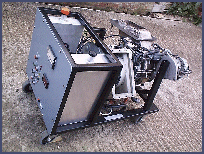
Now for the noise !
If you would like to hear the unit start and shut down, click here for wav file, or here for mp3 file. (In Explorer right click, then Save As) This file is large, 1MB for the wav, 0.5MB for the mp3, 45 seconds play time, so if you download this you are truly obsessed too. If you listen carefully, you can hear the two-stage starter jump from ballasted to flat chat, followed by a leisurely ignition (around 4 seconds) and slow spool to idle. At about 15 seconds, APU mode (~70% N1 max.) is selected, and the sound recorder goes a bit deaf. At 27 seconds, the unit is shut down.
I learnt a lot about this engine from an Air Publication document, kindly lent to me by Ian Bennett. This wonderful document covers every aspect of the APU and its control system. Thanks Ian !! Ian Bennett's turbine hobby pages